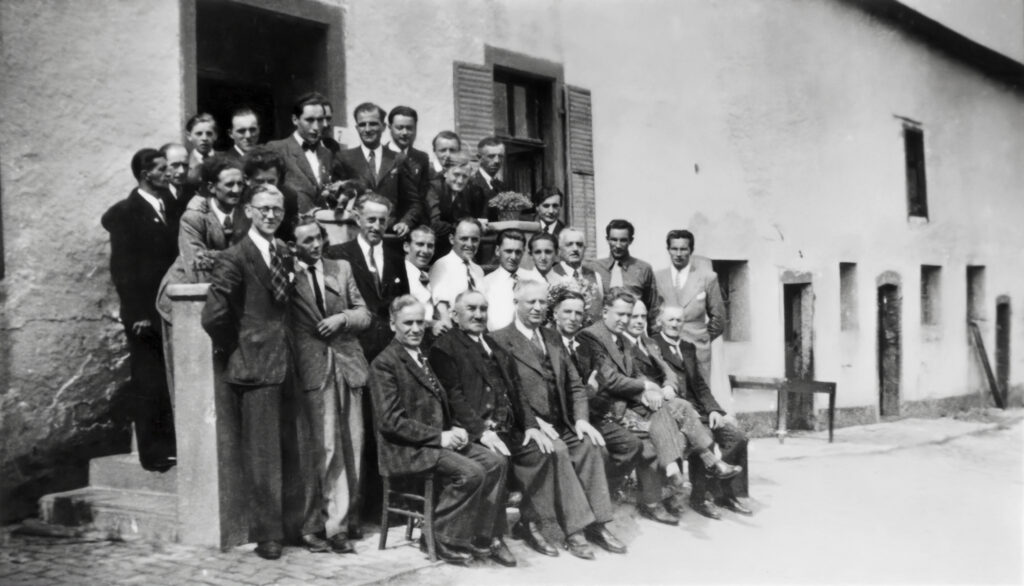
Header photo summer 1945 big reunion at the Kergen family farm in Sassel to welcome back younger brother Jängl Kergen from the Eastern front. Pierre Schon middle of the second row in white with fellow resistance fighter Pierre Kergen on his left surrounded by the Kergen family, Eugène Kremer, cousins Hub and Franz Conzemius, Jany and Norb Morn, René and Roger Martin and more of their resistance friends from the north. © L.P.P.D
Europe in ruins
When Nazi Germany surrendered on 8 May 1945 much of Europe lay in ruins. About one third of the roads, bridges and housing structures in Luxembourg were destroyed, even more in the north where the really heavy fighting had taken place. Food was short and rationing was in place. During the war approximately 4,000 people had been deported, 2,000 of whom were political prisoners, many to what is today Poland. They now needed to make their way back home. Millions of refugees and prisoners were underway trying to find their way back to their families with no way to update them that they were alive or when they would be arriving. Others fled to safety, eg millions of German civilians escaping from the advancing Soviet red army.
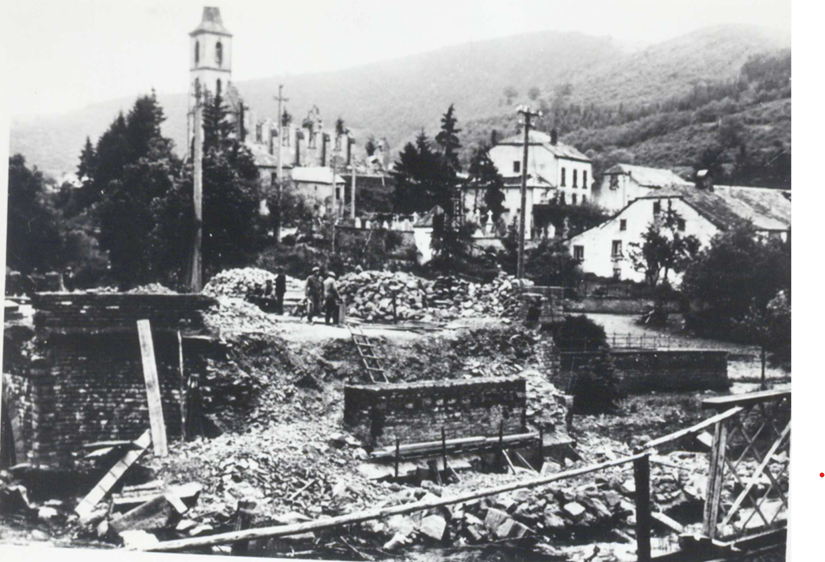
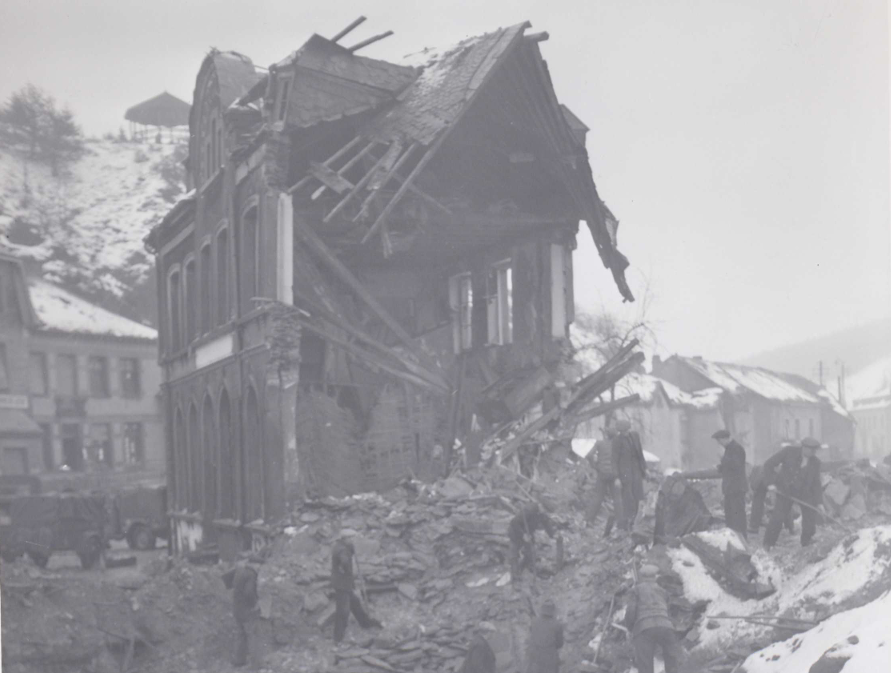
Photo top left: © ANLux FD005-10-002. 24 May 1945. Right: Troisvierges clean up 31 Jan 45 after 90th Div US army push out German troops. Photo © ANLux 005-01-022
Pierre returned to the family farm in early February 1945. At 30 years old, after five years of war, all he owned was the shirt on his back. Still, he was grateful to be alive. When he had fled from the Gestapo in April 1943, they had raided the farm, seizing his clothes, bicycle, and savings book. He had later given his remaining clothes to Allied airmen he was helping, so they could better pass as civilians. Feeling he had sacrificed so much during those harsh years, Pierre wrote to the International Red Cross, including his measurements, to ask if they might provide him with some clothing.
Still putting others first
In the months that followed, Pierre Schon invested much time and effort in refugee relief efforts. He was a generous person, a humanitarian naturally disposed to helping those in need as his time during the war had proven. Luxembourg, centrally located in Western Europe, became a destination for many refugees and displaced persons who had fled the devastation of the war.
He assisted refugees who arrived in Luxembourg, providing them with shelter, food, and other essential services such as housing and integration support through his active involvement with movements such as the Luxembourg Red Cross Refugee Relief Centre. He also helped the C.I.C, guiding, during the counter offensive, convoys of refugees to Belgium and visiting the embassy in Brussels to regularise their paperwork . He worked closely with the F.F.I. (unified French resistance) to help repatriate French prisoners of war. On the certificate detailing his achievements when he received his order of the resistance medal, he was commended for his relief work and described as a ‘key figure in the operation of civilian and military refugee centres’.
A brief encounter – David and Goliath
Not many resistance fighters can say they came face to face with Hermann Göring, President of the Nazi parliament (Reichstag), founder and Commander-in-Chief of the Luftwaffe, the powerful German air force, and designated successor to Hitler until April 1945 and live to tell the tale.
Camp Ashcan was established by the U.S. military in May 1945 in the Palace Hotel in Mondorf-les-Bains (Luxembourg’s luxurious spa hotel at the time). It served as a temporary interrogation and holding centre for high-ranking Nazi officials after they were captured by the Allies in Germany. Among those held at Ashcan were Hermann Göring, Joachim von Ribbentrop, Karl Dönitz, and many others. Interrogations at Ashcan were part of the information-gathering process ahead of the Nuremberg Trials, which began in November 1945.
In late spring Pierre Schon watched Herman Göring strolling around the garden enjoying the sunshine. The thing that struck Pierre most was how well dressed Göring was and apparently relaxed and smiling. Pierre had survived this long and cruel war and was a free man. Here right in front of him was one of the leaders of the powerful Nazi war machine that had occupied most of Europe for over four long years bringing total chaos in its wake. It seemed almost surreal.
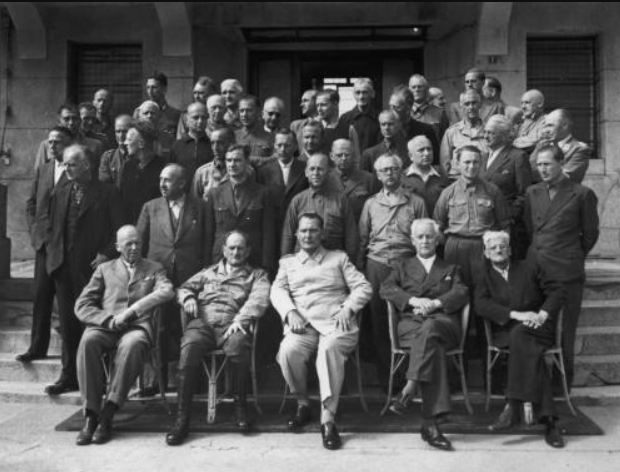
Inmates of Ashcan. Hermann Göring front row centre. Photo in the public domain taken by the US government.
In late August 1945, Göring and the others were flown to Nuremberg in preparation for the International Military Tribunal, which began in November 1945. Articulate and unrepentant, Göring was found guilty on 1 October 1946 of all four counts (conspiracy to wage aggressive war, crimes against peace, war crimes, and crimes against humanity) and sentenced to death by hanging. On 15 October, he committed suicide by swallowing a cyanide capsule in his prison cell just hours before his scheduled execution.
A big thank you and celebrations all round
With the war over, it was now time to extend a huge thank you and display of gratitude to the Belgians for the help they had given to their Luxembourg guests, to hide and help allied airmen, French POWs, young Luxembourgers escaping forced conscription into the German army.
Also on behalf of the Luxembourg maquisards living in the forest camps, many of whom became freedom fighters in the Belgian secret army and carried out acts of sabotage against the Nazi occupants.
On Saturday 1 September 1945, a large bus and several cars set off from Luxembourg direction the Belgian Ardennes on a two day road trip and series of celebrations. A full page article entitled ‘The Belgo-Luxembourg friendship’ appeared in the newspaper La Meuse Belge.
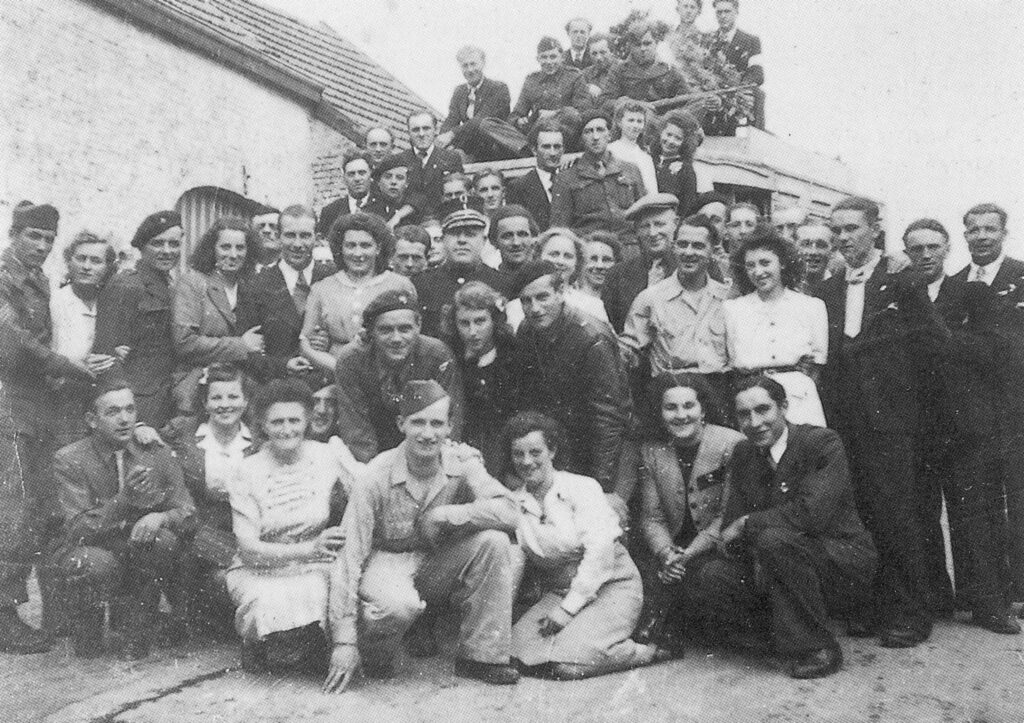
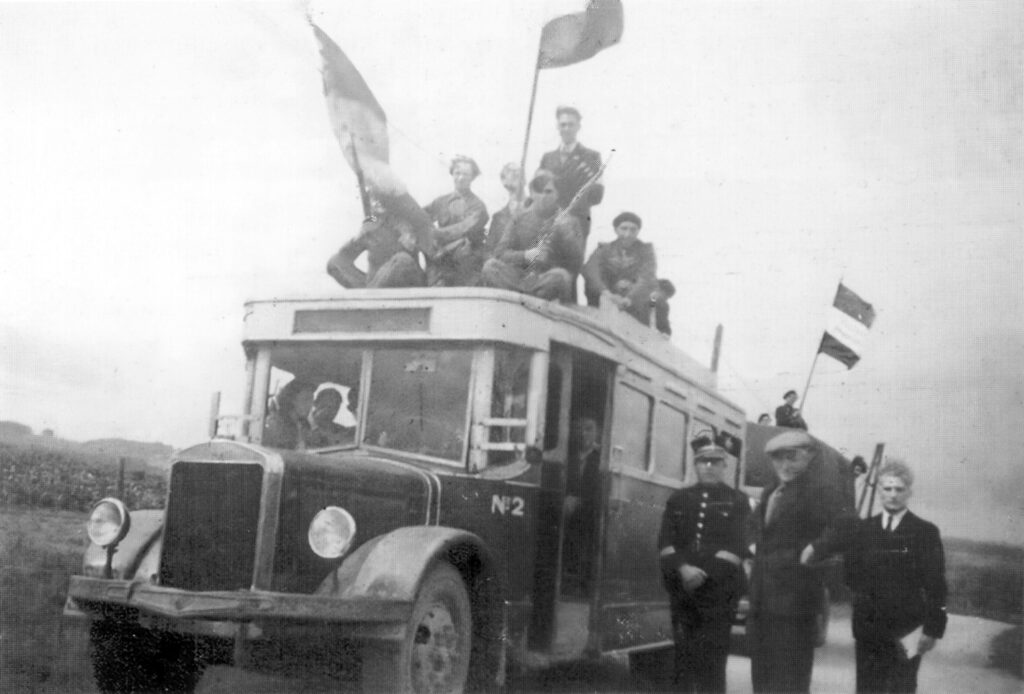
Photo top left: Welcome in Marloie. Pierre 2nd row third from left. Marie-Louise Didier second from left. RIght: Bus transporting the Luxembourg freedom fighters. Photos © Néckel Kremer from his 1994 book Erennerungen un Deemols.
First stop on Saturday was a ball organised in Marloie, the centre of the safehouse network set up by Jean Boever.
Pierre Schon spoke on behalf of the Luxembourg maquisards. ‘Devoted, you gave us sanctuary, showed us the way so we could fight the common enemy clandestinely, and together we were victorious and achieved the return of our beloved prisoners and deportees. Now the war is over, we have come to thank you for all your precious help.’
The Belgians applauded enthusiastically and shouted ‘Long live the Luxembourgers!’ That evening Pierre Schon presented the elected beauty of the ball with a big bunch of flowers and the traditional kiss.
Sunday morning, Abbot Heinen of Troisvierges, himself an ardent member of the Luxembourg resistance, conducted mass followed by the laying of a wreath at the war memorial. Next stop the ‘Marloie asylum’ as the network was affectionately known, to personally thank Jean Boever and René Nicolay for their invaluable help with providing safe houses and new identities for the over 200 escapees.
In combat, several maquisards were wounded and needed medical help. Doctor Docquier and his devoted team, including sister superior Antonia were the next to be warmly thanked during a visit to the hospital in Aye near Marche-en-Famenne. They were particularly happy to see again two of their former patients wounded in combat, whom they had nursed back to health, Joseph Morn and Joseph Tholl. The two men had returned afterwards to the forest camp to continue their combat against the Nazis.

Photo Dr Docquier and his team. © L.P.P.D
Lunch was arranged by the Boever family, then it was time to hit the road again direction Ciney, to extend profound thanks to the courageous Petit family and the local population. Entering the town of Ciney carrying flags, the Luxembourg maquisards were cheered and greeted by Mayor Bodart, a host of local dignitaries, and Henin, head of the resistance. The mayor announced Belgium was proud to have helped the Luxembourg freedom fighters. Pierre Schon reiterated the deep ties of friendship that united the two countries, which was followed by cries of ‘Long live Luxembourg, Long live Belgium.’ Everyone sang the two national anthems in a demonstration of pride, unity, and patriotism. The final stop was Haut Haversin, location of one of the biggest Belgian maquis with over 100 freedom fighters, including a dozen from Luxembourg, for another round of thanks to the local population and to the Belgian resistance.
“Gielemännchen” (literally “Yellow Men” in Luxembourgish)
Bringing collaborators to account after the war in all occupied countries was a controversial issue. The term Gielemännchen (“yellow men”) was adopted by many Luxembourgers, initially to refer to German Nazis in general and later extended to Luxembourg collaborators, deriving from the yellow uniforms of the Nazi Party. The term also came from the yellow-coloured identification cards (or files) that were used to mark suspected or confirmed collaborators after the war. These individuals faced various forms of punishment, including imprisonment, loss of citizenship rights, or social ostracisation.
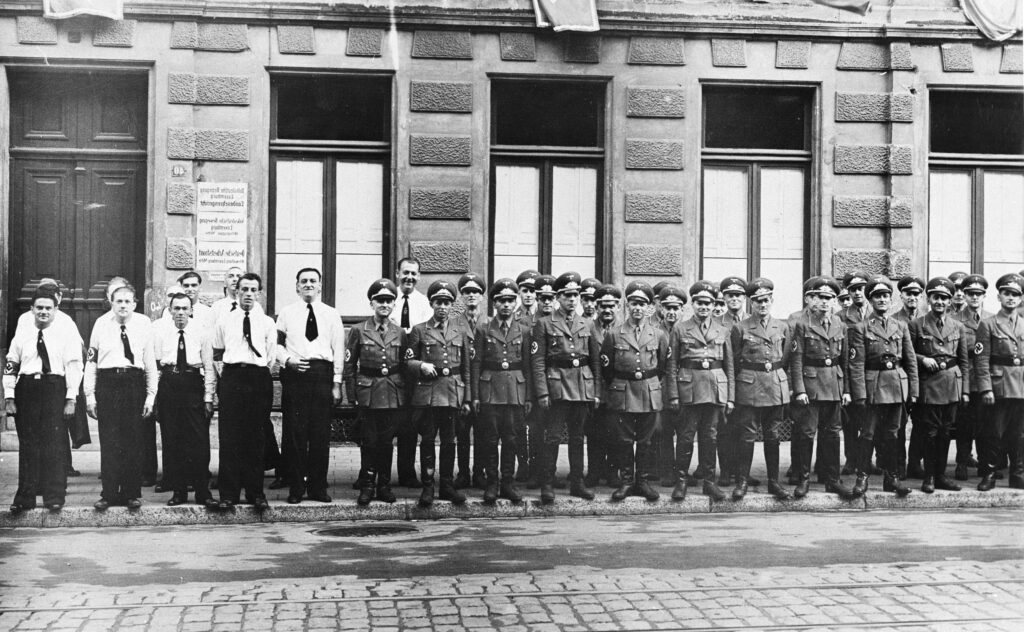
Gielemännchen © Photothèque de la ville de Luxembourg. Author unknown.
The main Luxembourg resistance groups formed the umbrella group Unio’n in March 1944, and they tried to establish a level of order after the German withdrawal but before the return of Luxembourg’s government-in-exile and this with the support of the American army. Without a legal footing, they arrested numerous collaborators. This may in fact have prevented the deadly vigilante justice that occurred in other countries, although the population in general remained angry towards arrested collaborators. Apart from their political activities, collaborators also had to account for their actions against Jews, denouncing members of the resistance and forced conscripts in hiding, as well as spying on Luxembourg’s population.
As a member of the LPL and later Unio’n, Pierre Schon took part in identifying collaborators in the immediate post war period. At the top of his list was Jules the Gestapo informant who had denounced Pierre’s good friend and fellow escape guide, Ernest Delosch, leading to his arrest, months’ long torture and execution in Cologne in February 1944. The betrayal also caused Marie-Louise Didier, another patriotic resistance member in Pierre’s network, much suffering, and almost her life in Ravensbrück then Neu-Brandenburg concentration camps. Jules escaped to visit family in France but was arrested upon his return. While in prison, he took his own life.
During and after the war, resistance movements had a pretty good idea of who the main collaborators were i.e. those whose actions had led to the arrest, torture, and even death of escaped forced conscripts, French prisoners of war and resistance fighters. Jules Dominique commended Pierre for his assistance in locating and arresting two alleged ‘Gestapo collaborators’ in Belgium: a field gendarme and a recruiter for the German army. Belgian authorities took a hard line on collaboration, with approximately 53,000 individuals tried by military tribunals. Of these, 2,940 received death sentences; however, only 242 executions were carried out by firing squad up until 1950.
Twelve top collaborators in Luxembourg, many of whom tried to hide in Germany after the war were caught and brought back to Luxembourg including the founder of the VdB Damian Kratzenberg. They were sentenced to death and Kratzenberg was executed by firing squad in Luxembourg city in October 1946. Some of the death sentences were commuted to life in prison before they could be carried out. Source Wikipedia.
In the years following the end of the war, 5,721 people were accused of collaboration with the Nazis before Luxembourg courts. Almost half of them — exactly 2,275 — were found guilty and sentenced.
Gustav Simon, the infamous Nazi Gauleiter (regional leader) was captured by Allied forces in May 1945 in West Germany, after going into hiding near Koblenz under a false name. He was held in British custody and was scheduled for transfer to Luxembourg to stand trial for war crimes and crimes against humanity but died in December 1945, in Paderborn prison under mysterious circumstances.
One of the most well known collaboration stories involved Pierre Prüm, a Luxembourgish politician and Prime Minister of Luxembourg from 1925 to 1926. He was the founder of the Independent National Party (PNI). Following the German annexation of Luxembourg in 1942, Prüm was appointed as the mayor of Clervaux under the new administration. After the war, Prüm was arrested, tried, and convicted for his collaboration which revolved around his public statements and support for German occupation policies. He was convicted in 1946 and sentenced to four years in prison, a relatively light sentence some claim compared to others accused of collaboration. He died in 1950 in Clervaux, not long after completing his prison term.
During the épuration (purge) from 1944 to 1950, Luxembourg citizens were required to fill out a declaration form, often referred to as a questionnaire de loyauté (loyalty questionnaire), as part of the épuration process. These forms were used by the authorities to assess each individual’s behaviour during the Nazi occupation. Responses were used to classify individuals for further investigation, legal action, or clearance. The magistrates who presided over these purging cases had almost all at one time been members of the VdB or the Rechtswahrerbund. The post-war irony: many of those judging alleged collaborators had themselves been affiliated with Nazi organizations.
By the late 1940s, Luxembourgish society sought stability and reconciliation: Amnesty laws were passed (notably in 1947, 1951, and 1955) to reintegrate many of the punished collaborators in an effort to restore national unity and recognise the complexities of life under occupation.
Immediately after the war, Pierre Schon felt that he had sacrificed so much for his country, risking his life on a daily basis for over four years and putting his family in constant danger. He felt many people, some of whom he believed had been too pro Nazi, had had a much easier time and were actually doing quite well for themselves. Time is a great healer however, and as he built his career and raised a family, these feelings of injustice subsided.
Complex and sensitive, collaboration became a bit of a taboo subject in the post war years in Luxembourg and something rarely dealt with among historians and in public discussion.
Gallery
Grand Duchess Charlotte returned to Luxembourg on 14 April 1945 and was warmly welcomed as a unifying national figure. During her time in exile in London, she served as a powerful symbol of Luxembourg’s resistance, broadcasting morale-boosting messages via the BBC and supporting the Allied cause diplomatically.
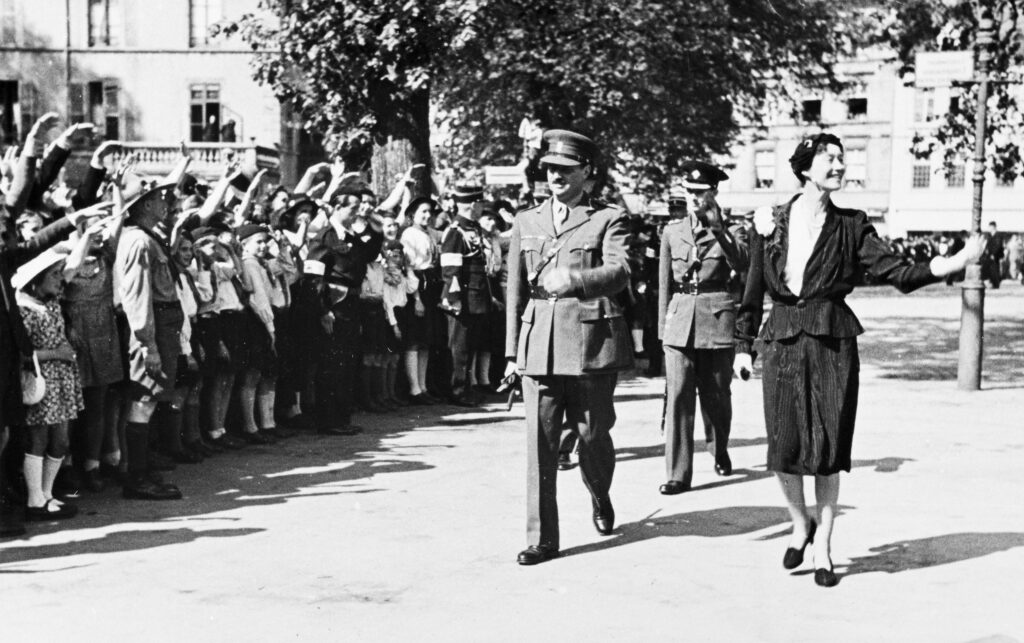
© Photothèque de la ville de Luxembourg. Author unknown.
Grand Duchess Charlotte walks through Luxembourg City accompanied by her husband Prince Felix and her son prince Jean, then Hereditary Grand Duke. Prince Jean joined the British Army in 1942, becoming a lieutenant in the Irish Guards and participated in the Normandy invasion (D-Day) in 1944 and the liberation of Brussels and Luxembourg City.
.